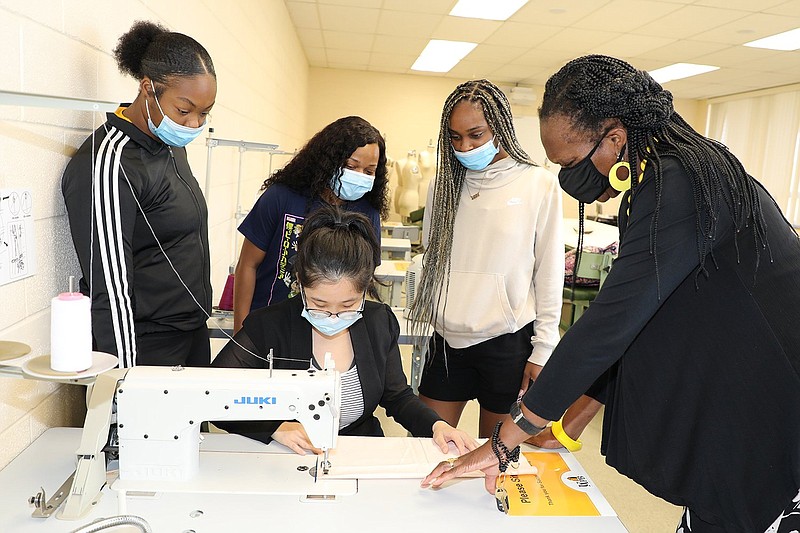When people think about September, Labor Day immediately comes to mind. People may also think about National Grandparents Day, Constitution Day and Hispanic Heritage Month. But did you know that September is also National Sewing Month?
According to Professor Doze Y. Butler of the University of Arkansas at Pine Bluff Department of Human Sciences, former President Ronald Reagan proclaimed the first National Sewing Month in 1982 "in recognition of the importance of home sewing to our Nation." Sponsors of National Sewing Month were the Sewing and Craft Alliance and the American Sewing Guild.
UAPB's Department of Human Sciences in the School of Agriculture, Fisheries and Human Sciences offers a merchandising, textiles and design concentration in their bachelor of science degree, Butler said.
The program provides students with a career-ready knowledge of the design process and fashion textiles. Courses in the MTD concentration include introduction to the apparel industry, introductory and advanced apparel design, basic and advanced textiles, fashion illustration, fashion buying and merchandising and an MTD internship.
Laboratories in the program, which provide students with practical experiences, are the design studio, the computer-aided design studio, the textile product development lab and the textile evaluation lab.
"Students matriculating through the program receive well-rounded academic preparation and are ready for careers in apparel design, product development, retailing and fashion styling, among others," she said.
National Sewing Month is celebrated in September but is enjoyed by "aficionados" every day of the year. Butler suggests that you can celebrate National Sewing Month in a variety of ways.
"Consider honing up on sewing skills or developing new skills. Learn about technological advancements in sewing machines. Contact fabric stores to find those that offer sewing classes," she said. "The University of Arkansas Cooperative Extension Service is another resource for sewing classes. And you may also want to consider the advantages of a B.S. degree in human sciences with a concentration in merchandising, textiles and design and the many career opportunities it offers."
MODERN SEWING
"Modern sewing is art," Butler said. "It has self-expression at its core. Creativity lies in the ability to take a two-dimensional piece of fabric and -- using needle (sewing machine or hand) and thread to create stitches -- turning it into a work of art."
Modern sewing also uses science, Butler said.
"Sewing incorporates practical applications of STEM (science, technology, engineering and math). Clothing is made from fibers and yarns that are made into fabrics. Most of the fibers used today (65 percent) are made in laboratories from synthetic materials or petrochemicals, such as nylon, acrylic, polyester and elastane," she said. "A working knowledge of chemistry is necessary to select the right manufactured fabrics for the chosen functional design. For example, if one wants to create athleisure wear, they will need to ensure the chosen fabric has enough stretch in all directions. That's science."
Prior to the sewing process, pattern pieces must be laid out in a certain way. In addition to ensuring the pattern pieces are laid out in the proper direction, you must lay them out so that fabric is not wasted, Butler said.
"Precise measurements need to be taken prior to cutting fabric. Measure twice; cut once applies to sewing as well as to architecture and construction projects," she said. "The two-dimensional shapes, when cut out and assembled appropriately, fit perfectly on a three-dimensional human body. Equally precise stitch lengths and seam widths are needed for durability and proper fit. All of this is math. Sewing involves critical thinking. Sewing solves problems."
SEWING HISTORY
Sewing dates back to the Upper Paleolithic Age, around 25,000 years ago. Bone, shell, wood and antlers were used to make simple tools. Bone and ivory were used to make the original hand sewing needles, Butler said. The purpose of sewing during this time was to produce clothing and to construct shelters. Paleolithic Era "fabrics" were animal hides and leaves from plants. "Thread" during this period was thin strips of animal hide.
"When you think about sewing, you rarely think about clothing being made from fig leaves as depicted in Genesis," she said. "Some may remember their grandmothers, great grandmothers and elderly neighbors making quilts and clothing by hand though."
Details: UAPB Department of Human Sciences, (870) 575-8806.
Debbie Archer is an Extension associate-communications at the UAPB School of Agriculture, Fisheries and Human Sciences.

